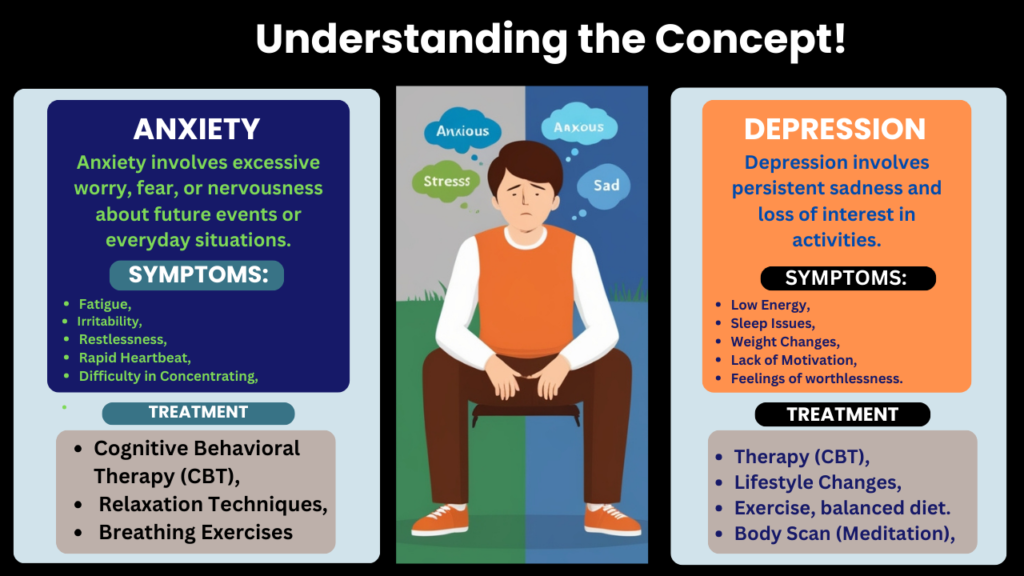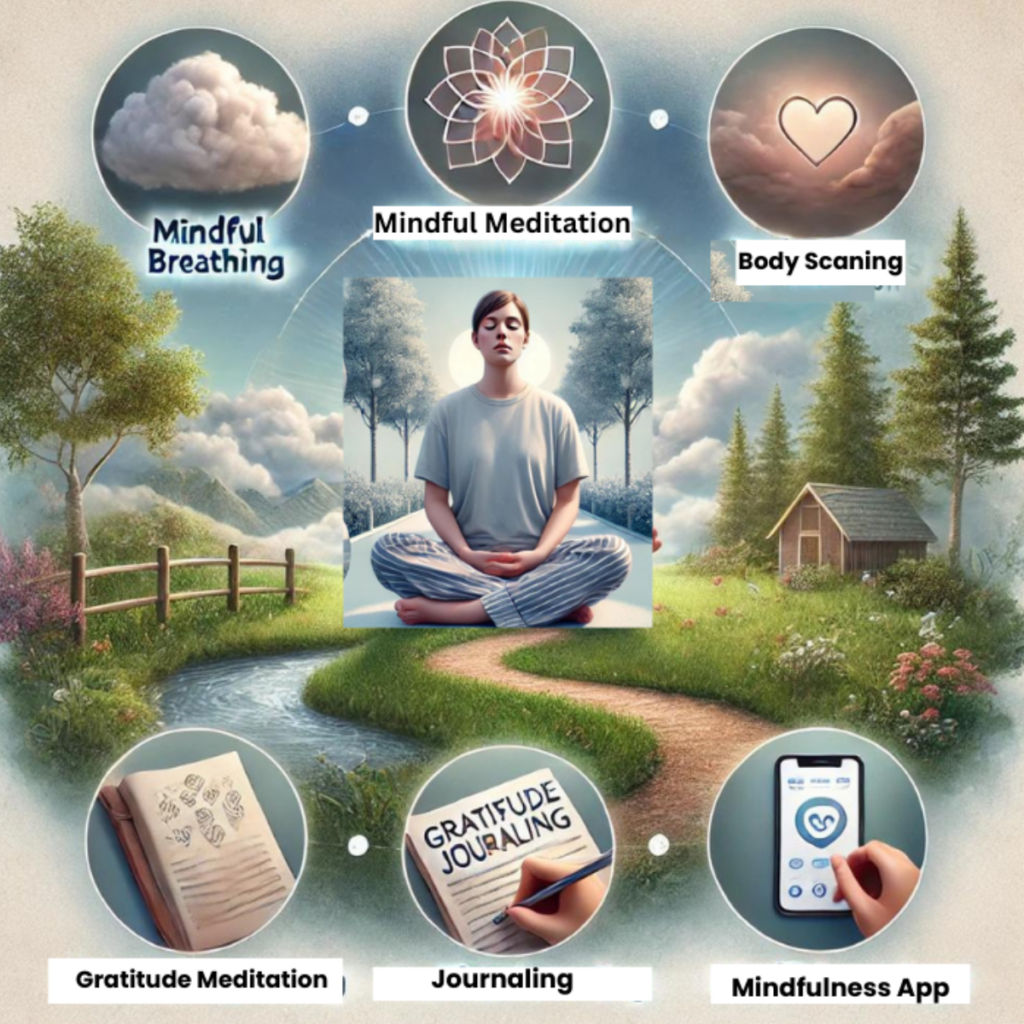“The greatest weapon against stress is our ability to choose one thought over another.” – William James

Have you ever felt trapped in a cycle of worry, sadness, or fear? Are you searching for clarity in the chaos of your emotions? You are not alone. Many individuals grapple with anxiety, depression, and PTSD. Understanding these conditions can be a powerful first step toward healing. In this blog, we will explore the science behind these mental health issues, their symptoms, and how mindfulness can serve as an effective tool for recovery.
What is Mindfulness?
In essence, mindfulness invites you to slow down, to savor the little things you often overlook, and to find beauty in the simplicity of now. Whether it’s the warmth of your morning coffee, the rhythm of your breath, or the sound of rain on the window, mindfulness helps you reconnect with these moments, guiding you away from autopilot living.

But how exactly do we cultivate mindfulness, especially regarding our mental well-being? In this post, I’ll walk you through simple yet powerful mindfulness techniques to help calm and center the mind. Whether you’re new to mindfulness or looking to deepen your practice, these steps will guide you toward a more peaceful, focused mental space. Let’s dive in!
Mindfulness offers a powerful approach to managing these mental health conditions by fostering awareness and promoting a non-judgmental acceptance of thoughts and feelings. Let’s explore how mindfulness can specifically help with depression, anxiety, and PTSD.
Today’s environment often leaves us trapped in cycles of anxiety, self-doubt, and emotional exhaustion. We scroll through curated lives online, measuring our worth against others, and the weight of constant competition can leave us feeling lonely, even in a crowd. We long for the close-knit conversations of the past, where sharing feelings and curiosity flourished. Mindfulness invites us to reclaim that connection—not only with others but also with ourselves.
Why Mindfulness is a Game-Changer for Mental Health?
Picture this: your mind is like a cluttered room, filled with worries, stress, and endless thoughts racing in all directions. Now, imagine opening a window in that room, letting in a breeze of fresh air and light. That’s exactly what mindfulness does for your mental health—it clears out the mental clutter and brings in a sense of calm and focus.
When you practice mindfulness, you give your mind a break from the constant noise. You’re not just managing stress, you’re learning to release it. Studies have shown that mindfulness can reduce symptoms of anxiety, depression, and emotional exhaustion. It helps you stay grounded in the present, rather than getting lost in worries about the future or regrets about the past.
But here’s the catch—mindfulness isn’t just a quick fix. Like any meaningful change, it requires practice. Just as you wouldn’t expect to build strength by lifting weights once, the benefits of mindfulness come with consistent effort. The more you practice, the more you train your brain to handle life’s challenges with calm and clarity.
So why should you make mindfulness a part of your life?
- It’s a tool to manage stress and bring moments of peace into your day.
- It teaches you to respond rather than react to situations, improving your emotional resilience.
- Mindfulness helps you cultivate self-compassion, so you can navigate life’s ups and downs with kindness toward yourself.
- It improves focus and boosts your ability to concentrate, allowing you to be more productive and present in whatever you do.
Practicing mindfulness isn’t just important—it’s transformative.
Understanding the Conditions

- Depression
What is Depression?
Depression is more than just feeling sad; it’s a complex mental health disorder characterized by persistent feelings of hopelessness, fatigue, and a lack of interest in activities.
Science Behind Depression:
Research indicates that depression is often linked to chemical imbalances in the brain, particularly involving neurotransmitters like serotonin, norepinephrine, and dopamine. Factors such as genetics, environment, and traumatic experiences can also play a significant role. Neuroimaging studies show that people with depression may have altered brain activity in areas related to mood regulation, decision-making, and impulse control.
Symptoms of Depression
- Fatigue or low energy,
- Feelings of worthlessness,
- Thoughts of death or suicide.
- Changes in appetite or weight,
- Persistent sadness or low mood,
- Loss of interest or pleasure in activities,
- Difficulty concentrating or making decisions,
- Sleep disturbances (insomnia or excessive sleeping),
Recognizing these signs is crucial, as untreated depression can lead to serious complications, including self-harm and suicidal thoughts.
2. Anxiety
What is Anxiety?
Anxiety is characterized by excessive worry, nervousness, and fear. It can manifest in various forms, such as Generalized Anxiety Disorder (GAD), Social Anxiety Disorder, and Panic Disorder.
Science Behind Anxiety:
Anxiety disorders are thought to stem from a combination of genetic predispositions, brain chemistry, and environmental stressors. The amygdala, a part of the brain responsible for processing fear, may be overactive in individuals with anxiety, leading to heightened responses to stress. Chronic anxiety can trigger a “fight or flight” response, causing physical symptoms like rapid heartbeat and sweating.
Symptoms:
- Irritability
- Muscle tension
- Sleep disturbances
- Excessive worrying or fear
- Restlessness or feeling on edge
- Physical symptoms such as rapid heartbeat,
- Sweating, and shortness of breath
Recognizing these symptoms is essential for effective management.
3. PTSD (Post-Traumatic Stress Disorder)

What is PTSD?
PTSD can develop after experiencing or witnessing a traumatic event, such as combat, assault, or natural disasters. It profoundly affects an individual’s emotional and psychological well-being.
Science Behind PTSD:
PTSD affects how the brain processes and responds to fear. The condition is often marked by alterations in the hippocampus, which is involved in memory processing, and the prefrontal cortex, responsible for regulating emotional responses. These changes can lead to flashbacks, nightmares, and heightened anxiety.
Symptoms:
- Avoidance of reminders associated with the trauma,
- Those experiencing PTSD must seek professional help,
- Intrusive memories or flashbacks of the traumatic event,
- As the condition can significantly impact daily life and relationships.
- Negative changes in mood or cognition, including feelings of detachment
- Hyperarousal symptoms, such as heightened startle response and difficulty sleeping
Practical Mindfulness Techniques

Incorporating mindfulness into your daily life doesn’t have to be daunting. Here are simple practices that can bring mindfulness into your routine:
1. Mindful Breathing
Take a few moments each day to focus on your breath. Find a quiet spot, close your eyes, and breathe deeply. This practice can ground you, providing instant relief from stress.
2. Body Scan Meditation
Lie comfortably and mentally scan your body from head to toe, releasing tension as you go. This fosters a deep awareness of your physical state, helping you relax.
3. Mindful Walking
Take a leisurely walk and immerse yourself in the sensations around you. Feel the ground beneath your feet and notice the sights and sounds, reconnecting with the world.
4. Gratitude Journaling
Dedicate a few minutes each day to write down things you’re grateful for. This shifts your focus from negative thoughts to positive experiences, cultivating an optimistic mindset.
5. Mindfulness Apps
Explore mindfulness apps like Headspace or Calm, which offer guided meditations and exercises that fit seamlessly into your lifestyle.
Mindfulness: A Cultural Shift
Mindfulness is not just an individual journey; it’s reshaping entire communities. Schools are incorporating mindfulness programs to support students, helping them focus and manage emotions. Corporations are recognizing the importance of mental well-being, implementing mindfulness initiatives that foster productivity and job satisfaction.
Looking Ahead: Mindfulness and Mental Health
As we move forward, the integration of mindfulness in mental health care is poised to grow. Therapists are increasingly incorporating mindfulness techniques into their practices, recognizing its effectiveness alongside traditional methods. Innovative technologies, such as virtual reality experiences, are also being explored to enhance mindfulness training, making it more accessible than ever.
Conclusion: Embracing Your Mindfulness Journey
Mindfulness is more than a trend; it’s a powerful practice that can transform your mental health. By embracing present-moment awareness, you can navigate life’s ups and downs with resilience and grace. Even dedicating a few minutes each day to mindfulness can lead to profound changes in your emotional well-being.
As you begin your mindfulness journey, remember that even a few moments of practice each day can lead to profound changes in your mental well-being. Open your heart to the possibilities that mindfulness offers, and let it guide you toward a calmer, more balanced life.
In a world that often pulls us in many directions, mindfulness stands as a beacon of hope. Are you ready to embark on this transformative journey? Embrace the calm within the storm and reconnect with what truly matters.
Engaging with Common Queries
Many individuals turn to platforms like Quora to seek answers about mental health. Here are some frequently asked questions:
– “Can mindfulness really help with my anxiety?”
Yes, numerous studies confirm that mindfulness can effectively reduce anxiety symptoms, fostering a sense of calm and clarity. Learning to observe thoughts without immediate reaction can decrease the emotional weight of anxiety.
– “How do I start practicing mindfulness?”
Begin with just five minutes a day dedicated to mindful breathing or a short meditation. Consistency is key; even small practices can lead to significant benefits over time. Consider setting a daily reminder or integrating mindfulness into your routine.
– “Is mindfulness effective for PTSD?”
Yes, research supports mindfulness as a beneficial intervention for PTSD, helping individuals process trauma and regain a sense of safety. Mindfulness techniques can provide tools for managing intrusive memories and emotional dysregulation.
Are you ready to embark on your mindfulness journey? Embrace the calm within the storm, and reconnect with what truly matters.
Subscribe to our newsletter for more insights on mental health and mindfulness. Share this post with friends and family to help them start their mindfulness journey too!




One Response